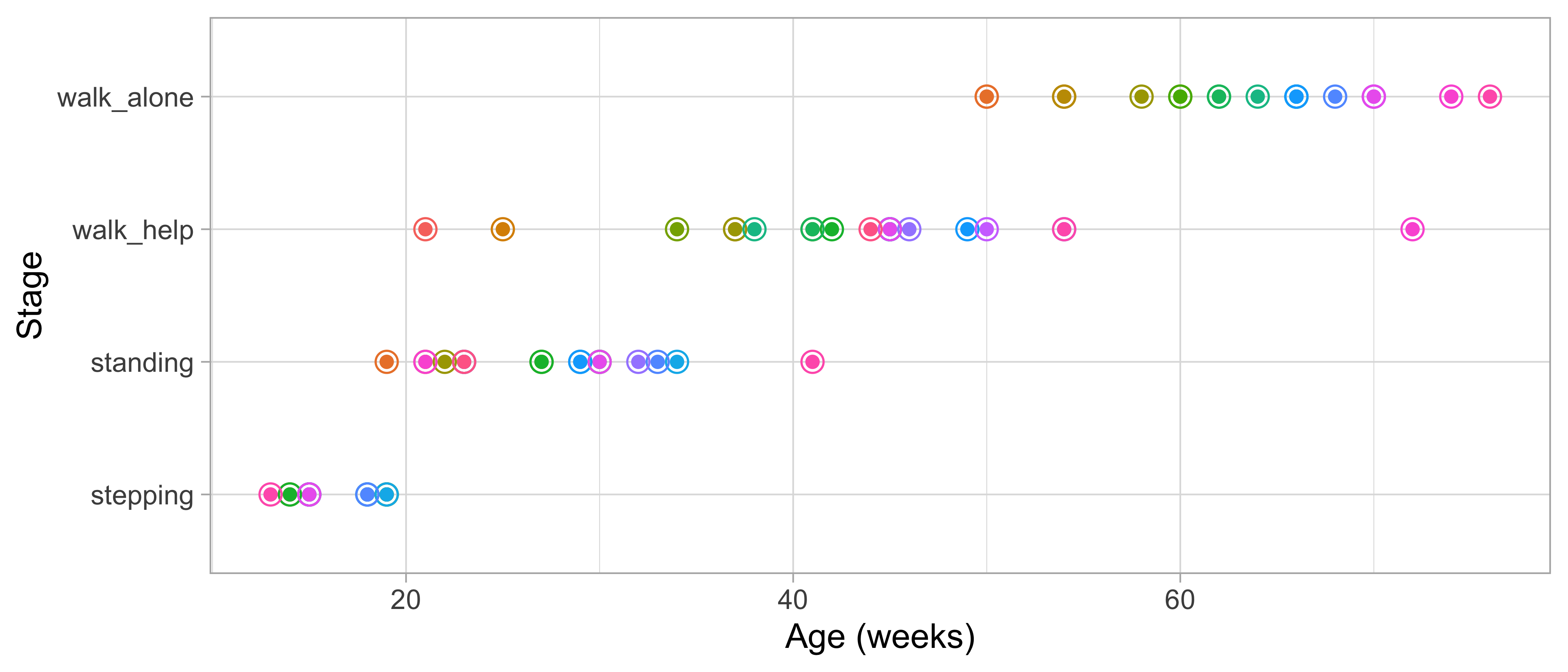3.1 Age-based measurement of development
3.1.1 Motivation for age-based measurement
Milestones form the based building blocks for instruments to measure child development. Methods to quantify growth using separate milestones relate the milestone behaviour to the child’s age. Gesell (1943) (p. 89) formulated this goal as follows:
We think of behaviour in terms of age, and we think of age in terms of behaviour. For any selected age it is possible to sketch a portrait which delineates the behaviour characteristics typical of the age.
There is an extensive literature that quantifies development in terms of the ages at which the child is expected to show a specific behaviour. The oldest methods for quantifying child development calculate an age equivalent for achieving a milestone, and compare the child’s age to this age equivalent.
3.1.2 Age equivalent and developmental age

Figure 3.1: Ages at which 21 children achieve four motor development milestones.
Figure 3.1 graphs the ages at which each of the 21 children enter a given stage in Shirley’s motor data of Table 2.1. Since standing follows stepping, children who can stand are older than the children who are stepping. Hence the ages for standing are located more to the right.
Since age and development are so intimately related, we can express the difficulty of a milestone as the mean age at which children achieve it. For example, Stott (1967) (p. 25) defines the age equivalent and its use for measurement, as follows:
The age equivalent of a particular stage is simply the average age at which children reach that particular stage.

Figure 3.2: Mean (symbol x) and spread of the ages at which 21 children achieve four motor development milestones.
Figure 3.2 adds the mean age and the boxplot at which the children enter the four stages. The difficulty of these milestones can thus be expressed as age equivalents: 16.1 weeks for stepping, 27.2 weeks for standing, 43.3 weeks for walking with help and 63.3 weeks for walking alone.
Thus, a child that is stepping beyond the age of 16.1 weeks is considered later than average, whereas a child already stepping before 27.2 weeks earlier than average. We may also calculate age delta as the difference between the child’s age and the norm age, and express it as “two weeks late” or “three weeks ahead.” Summarizing age delta’s over different milestones has led to concepts like developmental age as a measure of a child’s development.
3.1.3 Limitations of age-based measurement
Age-based measurement is easy to understand, and widely used in the popular press, but not without pitfalls:
- Age-based measurement requires us to know the ages at which the child entered a new stage. The mean age can be a biased estimate of item difficulty if visits are widely apart, irregular or missing.
- Age-based measurement can inform us whether a child is achieving a given milestone early of late. However, it does not tell us what behaviours are characteristic for children of a given age.
- Age-based measurement cannot exist without an age norm. When there are no norms, we cannot quantify development.
- Age-based measurement works only at the item level. Although we may average age delta’s over milestones, the choice of milestones is arbitrary.